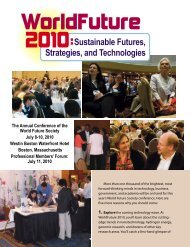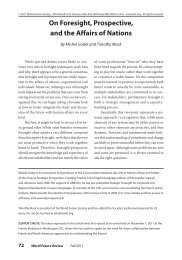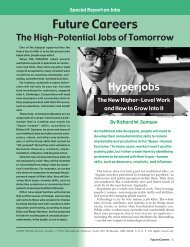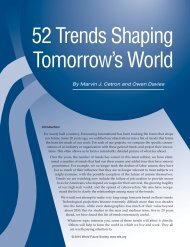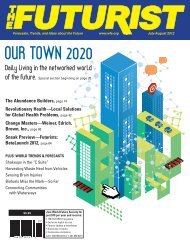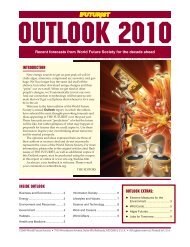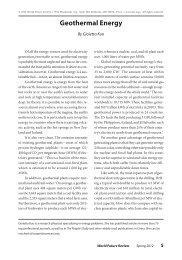Trends Shaping Tomorrow's - World Future Society
Trends Shaping Tomorrow's - World Future Society
Trends Shaping Tomorrow's - World Future Society
Create successful ePaper yourself
Turn your PDF publications into a flip-book with our unique Google optimized e-Paper software.
• Throughout the developed<br />
world, population growth is fastest<br />
among the elderly. In the United<br />
States, there are 4.2 million people<br />
age 85 and up. By 2050, there will be<br />
19.3 million.<br />
• In Europe, the United States, and<br />
Japan, the aged also form the wealthiest<br />
segment of society.<br />
• In the United States, at least,<br />
suburban populations are aging<br />
faster than those in the cities.<br />
Assessment and Implications:<br />
Not counting immigration, the ratio<br />
of working-age people to retirees<br />
needing their support will drop dramatically<br />
in the United States, Germany,<br />
Italy, Russia, Japan, and other<br />
countries. This represents a burden<br />
on national economies that will be<br />
difficult to sustain under current<br />
medical and social-security systems.<br />
In the next two to three decades,<br />
barring dramatic advances in geriatric<br />
medicine, shortages of health<br />
workers will loom large in “aging<br />
vulnerable” countries. The United<br />
States in particular will need at least<br />
twice as many physicians specializing<br />
in geriatrics as its current 9,000,<br />
as well as half a million more nurses<br />
by 2020.<br />
Suburban communities are likely<br />
to face a growing demand for social<br />
services such as senior day care, public<br />
transportation, and other programs<br />
for the elderly. This will place<br />
a growing strain on local government<br />
budgets.<br />
In the developing countries, where<br />
the elderly have traditionally relied<br />
on their children for support, this<br />
system will begin to break down as<br />
middle-aged “children” find themselves<br />
still supporting their parents<br />
while anticipating their own retirement.<br />
■<br />
Mass migration is redistributing<br />
the world’s population.<br />
• The International Organization<br />
for Migration estimates that there<br />
were some 214 million international<br />
migrants in the world as of 2008, including<br />
20 to 30 million unauthorized<br />
migrants. About 70 million migrants<br />
live in Europe, 61 million in<br />
Asia, 50 million in North America,<br />
and 20 million in Africa.<br />
• There are nearly 100 million in-<br />
ternational migrant workers in the<br />
world, according to the United Nations.<br />
About one-third live in Europe,<br />
with slightly fewer in Asia and North<br />
America. (These figures include only<br />
the workers themselves, not their dependents.)<br />
• Immigration to western Europe<br />
from eastern Europe, North Africa,<br />
the Middle East, and the Indian subcontinent<br />
continues despite controls<br />
enacted in the wake of terrorist attacks.<br />
Between 3 million and 4 million<br />
more migrants are expected to<br />
reach Europe in the next 25 years. A<br />
November 2009 survey by Ipsos<br />
MORI found that one-third of Britons<br />
considered race relations and immigration<br />
among the most important<br />
issues facing the U.K., up nine percentage<br />
points from the previous<br />
month.<br />
• In China, about 160 million<br />
people have moved from rural areas<br />
to cities in recent years.<br />
• Immigration is quickly changing<br />
the ethnic composition of the U.S.<br />
population. In 2000, Latinos made<br />
up 12.6% of the U.S. population; by<br />
2050, they will account for 24.5%.<br />
Asians in the United States, currently<br />
3.8% of the population, will comprise<br />
8% by 2050, according to the latest<br />
U.S. Census Bureau figures.<br />
• Higher fertility rates among the<br />
immigrant Latino population will accelerate<br />
this trend. As of 2002,<br />
women in the United States produced<br />
about two children during<br />
their lives, just enough to maintain<br />
the population. Among Hispanics,<br />
the average was more than 2.7 births<br />
per woman. Among Mexican immigrants,<br />
it was nearly 2.9.<br />
• At the same time, there is a small<br />
countertrend of Gen Xers and, especially,<br />
millennials moving to other<br />
countries to pursue business opportunities<br />
or for cultural interest.<br />
Assessment and Implications: Migration<br />
will accelerate in the years<br />
ahead as native workforces shrink in<br />
most developed lands.<br />
Impoverished migrants will place<br />
a growing strain on social-security<br />
systems in the industrialized countries<br />
of Europe and North America.<br />
Similar problems will continue to afflict<br />
the urban infrastructures of<br />
China and India.<br />
Remittances from migrants to their<br />
native lands are helping to relieve<br />
poverty in many developing countries.<br />
Globally, these payments exceeded<br />
$230 billion in 2005, according<br />
to the <strong>World</strong> Bank.<br />
Significant backlashes against foreign<br />
migrants, such as the skinhead<br />
movement in Europe, will be seen<br />
more frequently in the years ahead,<br />
even in the most peaceful lands. For<br />
example, in Scandinavia, resentment<br />
against foreign workers is strong, in<br />
part because they can return to their<br />
native lands after three years of employment<br />
and collect a pension equal<br />
to the minimum wage for the rest of<br />
their lives.<br />
Since the terrorist attacks of September<br />
11, 2001, and the rail bombings<br />
in London and Madrid, the<br />
large number of Muslim immigrants<br />
in Britain, France, and other European<br />
lands has inspired suspicion<br />
and some persecution.<br />
Unfortunately, suspicion is to some<br />
extent justified. A tiny minority of<br />
Muslim immigrants have proved to<br />
be linked to terrorist groups, and<br />
some have plotted or carried out terrorist<br />
attacks. So have native-born<br />
Muslims and converts to Islam.<br />
Societal <strong>Trends</strong><br />
■<br />
Values are changing rapidly.<br />
• Witness a February 2010 poll<br />
showing that 70% of Americans believe<br />
the United States should repeal<br />
the “don’t ask, don’t tell” policy that<br />
allows gay men and lesbians to serve<br />
in the military only if they hide their<br />
sexual orientation, while nearly 60%<br />
believe they should be allowed to<br />
“serve openly.”<br />
• Industrialization raises educational<br />
levels, changes attitudes toward<br />
authority, reduces fertility, alters<br />
gender roles, and encourages<br />
broader political participation. This<br />
process is just beginning throughout<br />
the developing world. Witness the<br />
growing literacy, declining fertility,<br />
and broad voter turnout seen in<br />
India over the last decade.<br />
• Developed societies increasingly<br />
take their cue from mid-life Gen Xers<br />
and the millennial generation, rather<br />
than from the baby boomers who<br />
THE FUTURIST May-June 2010 41




